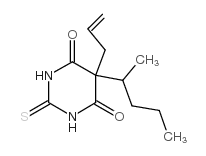thiamylal

thiamylal structure
|
Common Name | thiamylal | ||
|---|---|---|---|---|
| CAS Number | 77-27-0 | Molecular Weight | 254.34900 | |
| Density | 1.16g/cm3 | Boiling Point | N/A | |
| Molecular Formula | C12H18N2O2S | Melting Point | 132-133° | |
| MSDS | Chinese USA | Flash Point | N/A | |
| Symbol |

GHS06 |
Signal Word | Danger | |
|
Appropriate head position for nasotracheal intubation by using lightwand device (Trachlight).
Anesth. Prog. 61(2) , 47-52, (2014) The purpose of this study was to determine the relationship between the head position and the subsequent ease of nasotracheal intubation by using the lightwand device Trachlight (TL). Patients requiring nasotracheal intubation were subdivided into 3 groups ac... |
|
|
Cytotoxicity and type of cell death induced by midazolam in human oral normal and tumor cells.
Anticancer Res. 32(11) , 4737-47, (2012) Intravenous anesthetics have been used during the treatment of various malignant tumors, however, their effects on oral tissues is not well-understood. In the present study, the cytotoxicity of five intravenous anesthetics towards oral tumor and normal cells ... |
|
|
Effects of premedication medicines on the formation of the CYP3A4-dependent metabolite of ropivacaine, 2', 6'-Pipecoloxylidide, on human liver microsomes in vitro.
Basic Clin Pharmacol Toxicol. 98(2) , 181-3, (2006) Ropivacaine is a relatively new amide-type local anaesthetic, mainly used for surgery and postoperative pain relief. In this study we have investigated the interaction between the CYP3A4 metabolite of ropivacaine, 2',6'-pipecoloxylidide (PPX), and premedicati... |
|
|
Intravenous colforsin daropate, a water-soluble forskolin derivative, prevents thiamylal-fentanyl-induced bronchoconstriction in humans.
Crit. Care Med. 30(4) , 820-6, (2002) Forskolin, a direct activator of adenylate cyclase, can relax airway smooth muscle, similar to other agents that increase intracellular cyclic adenine monophosphate. However, the potential usefulness of forskolin in treating bronchospasm is limited by its poo... |
|
|
Intravenous nicorandil prevents thiamylal-fentanyl-induced bronchoconstriction in humans.
Crit. Care Med. 31(2) , 485-90, (2003) Nicorandil has a hybrid property between nitrates and potassium channel openers and has been reported to cause a concentration-dependent relaxation of isolated guinea pig trachealis. Experimental asthma in a guinea pig model was also inhibited by nicorandil. ... |
|
|
Intravenous alprostadil, an analog of prostaglandin E1, prevents thiamylal-fentanyl-induced bronchoconstriction in humans.
Anesth. Analg. 97(2) , 456-60, table of contents, (2003) Prostaglandin (PG) E(1) relaxes airway smooth muscle in animals. However, no clinical data have been published on the bronchorelaxant effects of IV alprostadil, an analog of PGE(1). We have described experimental thiamylal-fentanyl-induced bronchoconstriction... |
|
|
Efficacy and adverse effects of rectal thiamylal with oral triclofos for children undergoing magnetic resonance imaging.
Brain Dev. 28(3) , 175-7, (2006) We studied the efficacy and adverse effects of rectal thiamylal in combination with oral triclofos in sedation for pediatric magnetic resonance imaging. Five hundred forty-six children underwent MRI examination from January of 1997 to December of 2001. Among ... |
|
|
A study of the in vitro interaction between lidocaine and premedications using human liver microsomes.
J. Clin. Pharm. Ther. 30(2) , 185-8, (2005) To investigate potential interactions between lidocaine (lignocaine) metabolism and premedication drugs, i.e. psychotropic and antianxiety agents (diazepam, midazolam), hypnotics (pentobarbital, thiamylal), depolarizing neuromuscular blocking agents (vecuroni... |
|
|
Citosol (thiamylal sodium) triggers apoptosis and affects gene expressions of murine leukemia RAW 264.7 cells.
Hum. Exp. Toxicol. 31(8) , 771-9, (2012) Citosol (thiamylal sodium) is one of generally used anesthetic-sedative agents for clinical patients, and it has not been reported to show induction of cytotoxic effects in cancer cells, especially in mice leukemia RAW 264.7 cells in vitro. In the present stu... |
|
|
Effects of the intravenously administered anaesthetics ketamine, propofol, and thiamylal on the cortical renal blood flow in rats.
Pharmacology 68(1) , 17-23, (2003) Intravenous anaesthetics such as ketamine, propofol, and thiamylal are widely used, although the direct effects of these anaesthetics on the renal blood flow (RBF) have not been well elucidated. In this study, we examined the effects of bolus and continuous a... |